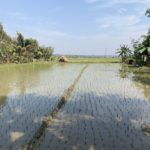The story of Bangladeshi muslin and the battle to own/claim it
In other words, this is about geography and history, politics and intrigue. But really it is the story of undivided Bengal
The first thing you need to know about jamdani is that it is a child of cotton. The best jamdani was woven in undivided Bengal using high count cotton.
Cotton fibers are single cells that extend from the seed coat epidermis. Their dimensions depend on the cotton species and variety. Thus the superfine Sea Island cotton (Gossypium barbadense) have a length of up to 5 cm and a linear density of 1 dtex, while the coarse Asiatic cotton (Gossypium herbaceum, Gossypium arboreum) have a length of about 1.5 cm and a linear density of 3 dtex. Dhakai jamdani was woven from the now extinct Gossypium arboretum var neglecta, colloquially called Phuti Karpash. This cotton grew on the banks of the river Meghana, which gave it a special fineness and resilience. The British tried their best to replicate these delicate cotton but couldn’t.
As Ruby Ghaznavi says in her essay in the book, “Traditional Jamdani Designs, spinning and weaving such high quality yarn required extraordinary skill. First the cotton was carded with the jawbone of a boalee fish to remove the smallest particles of seed or dirt. Then it was teased with a bow-like instrument known as dhunkar to separate the lightest fibers from the heavier ones. Finally, the downy fleece was wrapped with the soft skin of the cuchia fish to keep it from getting soiled during the spinning process.
Spinning was done by a group of young Brahmin women working with a spindle instead of the usual charkha. Spinning require humidity and coolness so it was done from dawn to sunrise, sometimes on boats in the middle of the river. On dry days, the yarn would be spun over shallow vessels of water to ensure moisture.
By the banks of the river Meghana in Bangladesh, in villages with musical names like Narayanganj sat aging Muslim weavers who worked with apprentices to make fabulous muslin weave. The “Ustads” or seniors sat beside the shagrid novices and woven the finest Dhakai jamdani. Most of them woven from memory using verbal instructions known as buli or bols.
Now, there is a push to figure out who owns jamdani. Bangladesh wants to stake its claim on this weave while India too wants to be part of it. Regardless of who “owns” it, all that we textile lovers want is for this amazing weave to thrive and flourish.
Banner and Images courtesy: Drik/Bangladesh and Saiful Islam.
Read about the link between Dhaka and Machilipatnam here. Of course, it has been mentioned in other places too.





